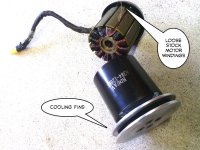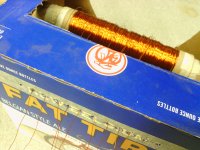SafeDiscDancing
10 kW
- Joined
- Jan 3, 2022
- Messages
- 514

Was working great all morning. Rode it hard for three full battery recharge cycles.
Then it looks like a loose wire got free and started a chain reaction frying the motor.
Argh !!! Rewind time.
The point of the post was to introduce the COOLING FINS.
See how they are aluminium and attach to the shell? This dramatically increases cooling over not having them. I have some foam in between to soften the noise.
It's a neat little trick to increase performance. My regular power usage is at peak about 2700 watts on the input side as read though a meter using a standardized shunt.
So far I've done thousands of miles with this type of motor but this is I think the sixth motor I've blown.
At about three pounds if I get three horsepower out of it then it's a good deal. Reliability could be better.
And let me add that "some" of these motors can last for thousands of miles and show no signs of heating in terms of burnt wires. So this one was purely electrical.
My last motor literally threw a magnet which had become unglued from the shell.




